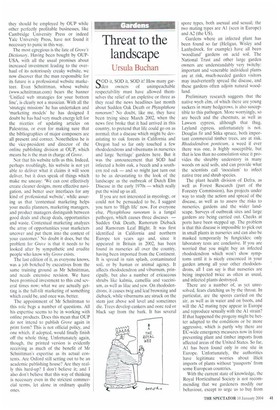threat to the landscape
Ursula Buchan
SOD it, SOD it, SOD it! How many garden owners of unimpeachable respectability must have allowed themselves the relief of an expletive or three as they read the news headlines last month about Sudden Oak Death or Phytophthora ramonan? No doubt, like me, they have been trying since March 2002, when the news first broke that it had arrived in this country, to pretend that life could go on as normal: that a disease which might be devastating to oak forests in California and Oregon had so far only touched a few rhododendrons and viburnums in nurseries and large 'heritage' gardens here. But it was the announcement that SOD had infected a holm oak, a beech and a southern red oak — and so might just turn out to be as devastating to the look of the landscape as the outbreak of Dutch Elm Disease in the early 1970s — which really put the wind up us all.
If you are not interested in mycology, or could not be persuaded to be, I suggest you turn to 'High life' now. For everyone else, Phytophthora ramorurn is a fungal pathogen, which causes three diseases — Sudden Oak Death, Ramorum Dieback and Rarnorum Leaf Blight. It was first identified in California and northern Europe ten years ago and, since it appeared in Britain in 2002, has been found in nurseries all over the country, having been imported from the Continent. It is spread in rain splash, contaminated soil, or by human or animal agency. It affects rhododendron and viburnum, principally, but also a number of ericaceous shrubs like kalmia, camellia and vacciniurn, as well as lilac and yew. On rhododendrons, it causes twig and leaf browning and dieback, while viburnums are struck on the stem just above soil level and sometimes die. Trees develop cankers and ooze red or black sap from the bark. It has several
spore types, both asexual and sexual; the two mating types are Al (seen in Europe) and A2 (the US).
Gardens where an infected plant has been found so far (Heligan. Wisley and Lanhydrock, for example) have all been 'woodland' gardens on acid soil. The National Trust and other large garden owners are understandably very twitchy: important and venerable individual plants are at risk, much-needed garden visitors may inadvertently spread the disease, and these gardens often adjoin natural woodland.
Preliminary research suggests that the native wych elm, of which there are young suckers in many hedgerows, is also susceptible to this pathogen. More worryingly, so are beech and the chestnuts, as well as Lawson cypress, although that thug, Leyland cypress, unfortunately is not. Douglas fir and Sitka spruce, both important commercial timber trees, are at risk. Rhododendron ponticum, a weed if ever there was one, is highly susceptible, but that is less than no consolation since it provides the shrubby understory in many woods on acid soils, and can provide what the scientists call `inoculunf to infect native tree and shrub species.
The plant health division of Defra, as well as Forest Research (part of the Forestry Commission), has projects under way to study the action and spread of the disease, as well as to assess the risks to nurseries, gardens and the wider landscape. Surveys of outbreak sites and large gardens are being carried out. Checks at ports have been stepped up. The problem is that this disease is impossible to pick out in small plants in nurseries and can also be masked temporarily by fungicides; only laboratory tests are conclusive. If you are worried that you might buy an infected rhododendron which won't show symptoms until it is nicely ensconced in your garden among all your other rhododendrons, all I can say is that nurseries are being inspected twice as often as usual, and infected plants destroyed.
There are a number of, as yet unre solved, fears clutching us by the throat. In particular, are the spores carried on the air, as well as in water and on boots, and will the A2 mating type appear in Europe and reproduce sexually with the Al strain? If that happened the progeny might be better adapted to the conditions or be more aggressive, which is partly why there are EC-wide emergency measures now in force
preventing plant and timber imports from affected areas of the United States. So far,
Al has been found only in one site in Europe. Unfortunately, the authorities have legitimate worries about illicit imports of plants without 'passports' from some European countries.
With the current state of knowledge, the Royal Horticultural Society is not recom mending that we gardeners modify our behaviour, except to urge us to buy from reputable sources, and to check already planted shrubs for signs of disease, comparing them to the photographs on Defra's website. If Phytophthora ramorum is suspected, we must get in touch with the local office of the Plant Health and Seeds Inspectorate, since this is a notifiable disease.
It is a pious hope to think that keen eyes, swift analysis and strict phytosanitary procedures will stop the disease spreading, but it is possible that Phytophthora matorum will in the end be confined to localised outbreaks. Rhododendrons can re-grow and findings so far indicate that our native oaks are much less susceptible than American species. They are also more genetically heterogeneous than elms, because the latter naturally spread by suckering. Certainly, the long-established and well-known Phytophthora root rots, which can weaken or kill a wide variety of species, are a nuisance rather than devastating to gardeners and foresters, and are controlled in nurseries. What is more, it is 150 years since Phytophthora infestans, potato blight, fundamentally changed the history of these islands and that of the United States. Surely, we have learned a few lessons since then?
For pictures of affected plants, visit www.defra.gov.ulaplanthloak.htm



























































 Previous page
Previous page